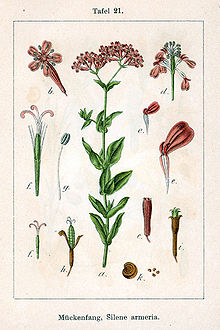Atocion armeria
| Atocion armeria | |
|---|---|
 | |
| Sweet William catchfly | |
| Scientific classification | |
| Kingdom: | Plantae |
| Clade: | Tracheophytes |
| Clade: | Angiosperms |
| Clade: | Eudicots |
| Order: | Caryophyllales |
| Family: | Caryophyllaceae |
| Genus: | Atocion |
| Species: | A. armeria |
| Binomial name | |
| Atocion armeria (L.) Raf. | |
| Synonyms | |
| List
| |
Atocion armeria, commonly known as Sweet William catchfly, is a species of plant in the family Caryophyllaceae. Originally a native of Europe, it has become widespread in the United States. A small-growing form is known as a dwarf catchfly. The name comes from the way in which small insects are trapped by the sticky sap exuded onto the stem. Although it has been identified as a carnivorous plant in the past, it is not currently regarded as such.[1]
Description
[edit]


The plant is between 20 and 70 centimetres (8 and 27+1⁄2 inches) in height. Leaves are numerous, ranging from 2.5–5 cm (1–2 in) long, elliptic, oval, or narrowly oval, smooth. The blooming period in British Isles is from June to October. Clusters of pink or lavender flowers arranged somewhat openly or compactly at the end of stems. Stem hairless (glabrous) or slightly hairy with sticky areas, especially just below the cluster.
Distribution and habitat
[edit]A plant native of Europe in roadsides, weedy places. Has been introduced to North America and later escaped cultivation to become an invasive species.
Perennial in USDA plant hardiness zones 5 to 8.
References
[edit]- ^ Williams, Amy. (1913). Carnivorous plants of Ohio. The Ohio Naturalist, 13(5): 97-99.
- ^ 9999.lt / 50 litas Coin featuring Lithuanian Nature, 2009
External links
[edit]- aphotoflora.com / Silene armeria - Sweet William Catchfly (Caryophyllaceae Images)
- pbase.com / Sweet William Catchfly


 French
French Deutsch
Deutsch